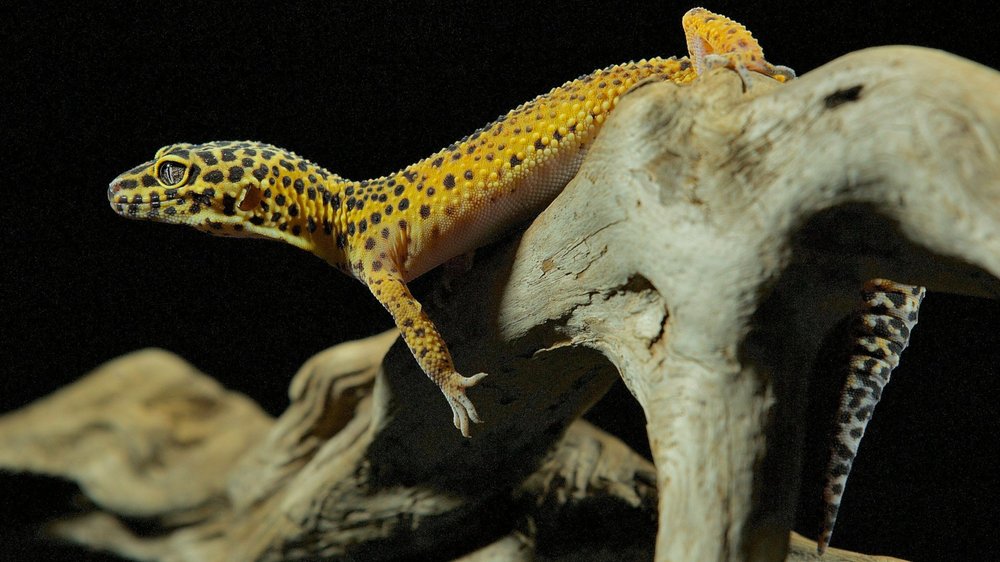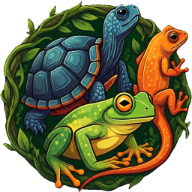
Eublepharis macularius
The leopard gecko (Eublepharis macularius) originates from Iran, Pakistan, Afghanistan, and West India. Unlike other geckos, leopard geckos have eyelids and can blink. They also lack adhesive pads and primarily live on the ground. Their tails can store fat for reserve purposes. These geckos exhibit a wide variety of color patterns, and their skin feels soft to the touch. They can grow up to 25 cm in length and have a lifespan of approximately 20 years. Leopard geckos grow quickly, reaching maturity within one and a half to two years.
Enclosure
Leopard geckos are solitary animals. They are best kept alone, as they can be territorial towards others. Females can also display territorial behavior towards each other. Housing them with other geckos can cause a lot of stress and lead to fighting, which may result in serious injury or death. Leopard geckos feel most comfortable when alone; just because they tolerate each other doesn’t mean they enjoy the company.
In nature, these geckos inhabit dry areas, and their bodies are well adapted to store fat reserves and moisture, primarily in their tails. It's crucial to ensure that the terrarium is not too humid. The minimum size for the terrarium should be 80x40x40 cm. The substrate should be approximately 5-10 cm deep to allow for digging, with sand being the most suitable material. It's best to use special terrarium sand, as other types may be too sharp.
For decoration, flat stones, such as slate, can be utilized. Ensure that the setup is securely anchored so that the geckos cannot get trapped underneath. There should be plenty of hiding spots available; you can create these by placing hollow cork. For plants, it is advisable to use artificial plants or succulents. Additionally, providing some moist moss in the coolest hide can assist them during shedding.
Temperature & Humidity
The temperature should be between 25-34 degrees Celsius, and the humidity should be between 50-60%. Normal living room humidity often falls within this range. The terrarium must have good ventilation and be placed in a draught-free location. Ensure that the gecko cannot access the heat source to avoid burns. It is beneficial to provide the terrarium with a background wall, as this helps reduce stress. They also need a day-night cycle of about 10-12 hours of light per day, which can be achieved by adding a timer. A lock is useful to prevent children from accessing the terrarium. To produce vitamin D3, leopard geckos require UV light. Reptiles synthesize vitamin D3 in their bodies thanks to UV light. They need D3 to absorb calcium. A UV lamp should be replaced once a year. It is best to opt for T5 or T8 lighting.
Care & Handling
Reptiles are primarily display animals and not pets for handling. Leopard geckos are easy to handle, but this will always cause stress. It is advisable to minimize handling as much as possible. If you do need to handle your reptile, for example for a health check, it is recommended to wash your hands before and after handling. It is important to keep the terrarium clean. The substrate, glass, and decorations should be free from waste, and any uneaten food items must be removed.
Food & supplements
Leopard geckos are carnivores and primarily eat animal food. Their diet may consist of crickets, Dubia roaches, wax worm larvae, silk worms, and grasshoppers. Wax worms are very high in fat, so they should not be given too often. Feed as much as the gecko can consume. The food should not be larger than the widest part of the gecko's mouth. A varied diet is important, as it contributes to the health of your reptile. The live prey items should be dusted with calcium and vitamins. Calcium helps with strong bones, and vitamins support the overall health of your reptile. These applications should not occur simultaneously; administer vitamins once a week and calcium on the other days. Young animals can be fed daily, while adults should be fed every other day. It's preferable to feed them in the evening. They should have access to fresh drinking water every day in a shallow dish
Conclusion & Difficulty
In conclusion, the leopard gecko is indeed one of the most commonly kept reptiles and is also one of the best-suited options for beginners. These fascinating creatures are remarkably resilient and hardy, which makes them a popular choice among new reptile enthusiasts. Furthermore, they can easily adapt to and thrive in a wide variety of environmental circumstances, providing a great opportunity for novice keepers to learn and grow in the world of reptile care.
Difficulty 1 out of 5
